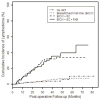The impact of radiation therapy on the risk of lymphedema after treatment for breast cancer: a prospective cohort study
- PMID: 24411624
- PMCID: PMC3928974
- DOI: 10.1016/j.ijrobp.2013.11.232
The impact of radiation therapy on the risk of lymphedema after treatment for breast cancer: a prospective cohort study
Abstract
Purpose/objective: Lymphedema after breast cancer treatment can be an irreversible condition with a negative impact on quality of life. The goal of this study was to identify radiation therapy-related risk factors for lymphedema.
Methods and materials: From 2005 to 2012, we prospectively performed arm volume measurements on 1476 breast cancer patients at our institution using a Perometer. Treating each breast individually, 1099 of 1501 patients (73%) received radiation therapy. Arm measurements were performed preoperatively and postoperatively. Lymphedema was defined as ≥10% arm volume increase occurring >3 months postoperatively. Univariate and multivariate Cox proportional hazard models were used to evaluate risk factors for lymphedema.
Results: At a median follow-up time of 25.4 months (range, 3.4-82.6 months), the 2-year cumulative incidence of lymphedema was 6.8%. Cumulative incidence by radiation therapy type was as follows: 3.0% no radiation therapy, 3.1% breast or chest wall alone, 21.9% supraclavicular (SC), and 21.1% SC and posterior axillary boost (PAB). On multivariate analysis, the hazard ratio for regional lymph node radiation (RLNR) (SC ± PAB) was 1.7 (P=.025) compared with breast/chest wall radiation alone. There was no difference in lymphedema risk between SC and SC + PAB (P=.96). Other independent risk factors included early postoperative swelling (P<.0001), higher body mass index (P<.0001), greater number of lymph nodes dissected (P=.018), and axillary lymph node dissection (P=.0001).
Conclusions: In a large cohort of breast cancer patients prospectively screened for lymphedema, RLNR significantly increased the risk of lymphedema compared with breast/chest wall radiation alone. When considering use of RLNR, clinicians should weigh the potential benefit of RLNR for control of disease against the increased risk of lymphedema.
Copyright © 2014 Elsevier Inc. All rights reserved.
Conflict of interest statement
Figures
Comment in
-
Radiotherapy: avoiding lymphedema.Nat Rev Clin Oncol. 2014 Mar;11(3):121. doi: 10.1038/nrclinonc.2014.8. Epub 2014 Jan 28. Nat Rev Clin Oncol. 2014. PMID: 24469743 No abstract available.
References
-
- Jäger G, Döller W, Roth R. Quality-of-life and body image impairments in patients with lymphedema. Lymphology. 2006;39:193–200. - PubMed
-
- Tobin MB, Lacey HJ, Meyer L, et al. The psychological morbidity of breast cancer-related arm swelling. Psychological morbidity of lymphoedema. Cancer. 1993;72:3248–52. - PubMed
-
- Khan F, Amatya B, Pallant JF, et al. Factors associated with long-term functional outcomes and psychological sequelae in women after breast cancer. Breast. 2012;21:314–20. - PubMed
-
- Ceilley E, Jagsi R, Goldberg S, et al. Radiotherapy for invasive breast cancer in North America and Europe: results of a survey. Int J Radiat Oncol Biol Phys. 2005;61:365–73. - PubMed
Publication types
MeSH terms
Grants and funding
LinkOut - more resources
Full Text Sources
Other Literature Sources
Medical


